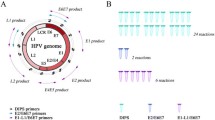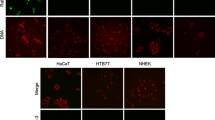Summary
The aim of this study was to investigate papillomavirus (HPV)-DNA in precancer and cancer of the cervix, vulva, and endometrium by in situ/dot blot/ Southern blot hybridization and polymerase chain reaction (PCR).Myc/erbB-2 expression was examined by Northern blot analysis. PCR was the most sensitive HPV detection method, demonstrating HPV-DNA in all preinvasive and invasive cervical lesions (n=21) and most (3 of 4) vulvar carcinomas in contrast to an overall rate of 60% with other techniques. Particular phenotypes (adenoid cystic/basal cell carcinoma of the vulva, cervical adenocarcinoma) were found to contain HPV. Endometrium harboured HPV not only in two cases of cervical cancer, but also in 3 of 8 primary endometrial carcinomas and 3 of 8 non-malignant conditions. activation was confined to three squamous cell carcinomas, most markedly in one HPV-6-positive verrucous variant.ErbB-2 over-expression was only seen in one HPV-18 infected advanced endometrial tumour. Our findings point to a range of HPV-infected lesions broader than previously supposed and possible contributions of HPV-independent molecular events to carcinogenesis in this field.
Similar content being viewed by others
References
Arends MJ, Wyllie AH, Bird CC (1990) Papillomaviruses and human cancer. Hum Pathol 21:686–698
Banks L, Edmonds C, Vousden KH (1990) Ability of the HPV 16 E7 protein to bind RB and induce DNA synthesis is not sufficient for efficient transforming activity in NIH3T3 cells. Oncogene 5:1383–1389
Bergeron C, Shah K, Daniel R, Ferenczy A (1988) Search for human papillomaviruses in normal, hyperplastic, and neoplastic endometria. Obstet Gynecol 72:383–387
Chirgwin JM, Przybyla AE, MacDonald RJ, Rutter WJ (1979) Isolation of biologically active ribonucleic acid from sources enriched in ribonuclease. Biochemistry 18:5294–5299
Crook T, Morgenstern JP, Crawford L, Banks L (1989) Continued expression of HPV-16 E7 protein is required for maintenance of the transformed phenotype of cells co-transformed by HPV-16 plus EJ-ras. EMBO J 8:513–519
Crook T, Wrede D, Vousden KH (1991) P53 point mutation in HPV negative human cervical carcinoma cell lines. Oncogene 6:873–875
Dallas PB, Flanagan JL, Nightingale BN, Morris BJ (1989) Polymerase chain reaction for fast, nonradioactive detection of highand low-risk papillomavirus types in routine cervical specimens and in biopsies. J Med Virol 27:105–111
De Villiers E-M, Schneider A, Gross G, zur Hausen H (1986) Analysis of benign and malignant urogenital tumors for human papillomavirus infection by labelling cellular DNA. Med Microbiol Immunol (Berl) 174:281–286
DiLuca D, Costa S, Monini P, Rotola A, Terzano P, Savioli A, Grigioni W, Cassai E (1989) Search for human papillomavirus, herpes simplex virus and c-myc oncogene in human genital tumors. Int J Cancer 43:570–577
DiPaolo JA, Woodworth CD, Popescu NC, Notario V, Doniger J (1989) Induction of human cervical squamous cell carcinoma by sequential transfection with human papillomavirus 16 DNA and viral Harveyras. Oncogene 4:395–399
Gissmann L, Wolnik L, Ikenberg H, Koldovsky U, Schnürcn HG, zur Hausen H (1983) Human papillomavirus types 6 and 11 DNA sequences in genital and laryngeal papillomas and in some cervical cancers. Proc Natl Acad Sci USA 80:560–563
Goldsborough MD, DiSilvestre D, Temple GF, Lorincz AT (1989) Nucleotide sequence of human papillomavirus type 31: a cervical neoplasia-associated virus. Virology 171:306–311
Hallam N, Gibson P, Green J, Charnock M (1989) Detection and typing of human papillomavirus infection of the uterine cervix by dot blot hybridization comparison of scrapes and biopsies. J Med Virol 27:317–321
Kessler II (1981) Etiological concepts in cervical carcinogenesis. Gynecol Oncol 12:17–21
King LA, Tase T, Twiggs LLB, Okagaki T, Savage JE, Adcock LL, Prem KA, Carson LF (1989) Prognostic significance of the presence of human papillomavirus DNA in patients with invasive carcinoma of the cervix. Cancer 63:897–900
Lorincz AT, Temple GF, Kurmann RJ, Jenson AB, Lancaster WD (1987a) Oncogenic association of specific human papillomavirus types with cervical neoplasia. J Natl Cancer Inst 79:671–678
Lorincz AT, Quinn AP, Lancaster WD, Temple GF (1987b) A new type of papillomarvirus associated with cancer of the uterine cervix. Virology 159:187–190
Macnab JCM, Walkinshaw SA, Cordiner JW, Clements JB (1986) Human papillomavirus in clinically and histologically normal tissue of patients with genital cancer. N Engl J Med 315:1052–1058
Maniatis T, Fritsch EF, Sambrook J (1982) Molecular cloning, a laboratory manual. Cold Spring Harbor Laboratory, Cold Spring Harbor, New York
Manos MM, Ting Y, Wright DK, Lewis AJ, Broker TR, Wolinsky SM (1989) Use of polymerase chain reaction amplification for the detection of genital human papillomaviruses. Cancer Cells 7:209–213
McCance DJ (1988) News on papillomaviruses. Nature 335:765–766
Okagaki T, Clark BA, Zachow KR, Twiggs LB, Ostrow RS, Pass F, Faras AJ (1984) Presence of human papillomaviruses in verrucous carcinoma (Ackerman) of the vagina. Arch Pathol Lab Med 108:567–570
Rando RF, Groff DE, Chirikjian JG, Lancaster WD (1986) Isolation and characterization of a novel human papillomavirus type 6 DNA from an invasive vulvar carcinoma. J Virol 57:353–356
Richard RM, Nuovo GJ (1990) Human papillomavirus DNA in situ hybridization may be used for the quality control of genital tract biopsies. Obstet Gynecol 75:223–226
Riou GF (1988) Proto-oncogenes and prognosis in early carcinoma of the uterine cervix. Cancer Surv 7:441–456
Rivière A, Wilckens C, Löning T (1990) Expression of erbandc-myc in squamous epithelia and squamous cell carcinomas of the head and neck and the lower female genital tract. J Oral Pathol Med 19:408–413
Scheffner M, Werness BA, Hulbregtse JM, Levine AJ, Howley PM (1990) The E6 oncoprotein encoded by human papillomavirus types 16 and 18 promotes the degradation of p53. Cell 63:1129–1136
Shibata DK, Arnheim N, Martin WJ (1988) Detection of human papillomavirus in paraffin-embedded tissue using the polymerase chain reaction. J Exp Med 167:225–230
Slamon DJ, Godolphin W, Jones LA, Holt JA, Wong SG, Keith DE, Levin WJ, Stuart SG, Udove J, Ullrich A, Press MF (1989) Studies of the HER-2/neu proto-oncogene in human breast and ovarian cancer. Science 244:707–712
Snijders PJF, Brule AJC van den, Schrijnemakers HFJ, Snow G, Meijer CJLM, Walboomers JMM (1990) The use of general primers in the polymerase chain reaction permits the detection of a broad spectrum of human papillomavirus genotypes. J Gen Virol 71:173–181
Tomita Y, Kubota K, Kasai T, Sekiya S, Takamizawa H, Simizu B (1986) Detection of human papillomavirus DNA in genital warts, cervical dysplasias and neoplasias. Intervirology 25:151–157
Tsunokawa Y, Takebe N, Nozawa S, Kasamatsu T, Gissmann L, zur Hausen H, Terada M, Sugimura T (1986) Presence of human papillomavirus type 16- and type 18-DNA sequences and their expression in cervical cancers and cell lines from Japanese patients. Int J Cancer 37:499–503
Van de Vijver MJ, Peterse JL, Mooi WJ, Wisman P, Lomans J, Dalesio O, Nüsse R (1988) Neu-protein overexpression in breast cancer. Association with comedo-type ductal carcinoma in situ and limited prognostic value in stage II breast cancer. N Engl J Med 319:1239–1245
Wilczynski SP, Walker J, Liao S-Y, Bergen S, Berman M (1988) Adenocarcinoma of the cervix associated with human papillomavirus. Cancer 62:1331–1336
Yokota J, Yamamoto T, Tokoshima K (1986) Amplification of c-erbB2 oncogene in human adenocarcinomas in vivo. LancetI:765–766
Yokota J, Tsukada Y, Nakajima T, Gotoh M, Shimosato Y, Mori N, Tsunokawa Y, Sugimura T, Terada M (1989) Loss of heterozygosity on the short arm of chromosome 3 in carcinoma of the uterine cervix. Cancer Res 49:3598–3601
Zur Hausen H (1987) Papillomaviruses in human cancer. Cancer 59:1692–1696
Author information
Authors and Affiliations
Rights and permissions
About this article
Cite this article
Milde-Langosch, K., Becker, G. & Löning, T. Human papillomavirus and c-myc/c-erbB2 in uterine and vulvar lesions. Vichows Archiv A Pathol Anat 419, 479–485 (1991). https://doi.org/10.1007/BF01650676
Received:
Revised:
Accepted:
Issue Date:
DOI: https://doi.org/10.1007/BF01650676




